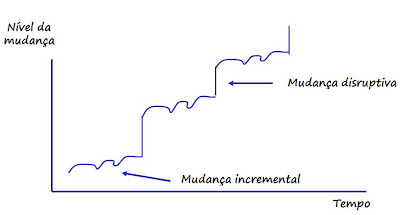Há dias, neste
espaço, interrogava-me por que é que tantas empresas em vez de evoluírem permanentemente, dia após dia, adormecem e atolam-se num status quo que não vai durar sempre. Esse ramram vai corroer a sua capacidade de mudar, o seu estado de preparação, a sua robustez.
.
Assim, quando se dá uma mudança na "maré" essas empresas perdem o pé e morrem.
.
Afinal, o que descrevi pode ser enquadrado no paradigma do equilíbrio pontuado (punctuated equilibrium). A ideia veio da paleobiologia e propõe que a evolução biológica não ocorre de forma gradual e contínua ao longo do tempo, mas antes através de saltos entre períodos de estabilidade:

"punctuated equilibrium suggests that organizations enjoy long periods of stability, or equilibrium. These periods of equilibrium are interrupted by compact, relatively short periods of
qualitative metamorphic change, or revolution. This is summarized in a definition...
.
Definition:
Organizations evolve through the
alternation of periods of equilibrium, in which persistent underlying structures permit only incremental change, (
Moi ici: quando estamos nestes períodos faz sentido apostar na melhoria da eficiência e no denominador da equação da produtividade) and
periods of revolution, in which these underlying structures are fundamentally altered. All organizations have a deep structure which consists of core beliefs and values; products, markets, technology, and competitive timing; distribution of power; basic internal structure; and type of control systems.
.
Deep structure
Each organization possesses what is called a deep structure, which forms its underlying order.
It is the deep structure which exists during periods of equilibrium, and limits change. Organizational deep structure has four facets: core beliefs and values; products, markets, technology, and competitive timing; distribution of power; and organizational structure and the nature of its control system."
.
Se calhar é pedir demais, ou esperar demais... pensar que uma massa crítica de empresas fuja a esta lógica da ditadura do equilíbrio.
.
O que muitos sectores industriais vivem actualmente é um período de revolução:
.
"Periods of revolution cause deep structures to disassemble, reconfigure, and undergo wholesale transformation.
There is a breakdown of the old equilibrium; a period of uncertainty about the future, and a new basis around which to form a new deep structure. Revolutionary periods close rapidly once a new deep structure is found.
Revolution causes complete breakdown because of the mutual interdependence of a system’s parts and action patterns. (
Moi ici: e querer manter as estruturas antigas para combater a nova guerra? E não perceber que o que sempre resultou agora não resulta, não chega... E começar a lançar culpas pelos colaboradores sem poder executivo...)
.
It is usually changes in the internal and/or external environment that cause revolutionary punctuations. Usually, internal growth strains existing organization practices and structures. External environmental changes which are significant include maturation of product life cycles; the legal and social climate; and substitute products and technologies. These shifts in and of themselves may not cause revolutionary punctuations, but they create the need which may precipitate the punctuation."
.
Trechos retirados
daqui.


%2006.21.jpeg)












